
The second day of our Irish Odyssey, 11 April, along the Wild Atlantic Way started at Skibbereen. George’s expression in these photos could represent “Before” and “After” though they were taken seconds apart. In “Before” he seems to be expecting the worst for Rory McIlroy, no Green Jacket, no Masters, and no Full Set. “After”, is altogether more benign, and could easily depict mild joy for McIlroy’s triumph of a few days later. (George was, in fact, ecstatic!)
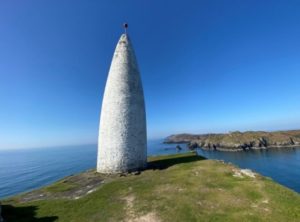 For our first call of the day, Brutus Tours needed to inspect Baltimore, after which its transatlantic and now much larger brother is named. We waited below as Algernon, true to form, climbed up to see the view.
For our first call of the day, Brutus Tours needed to inspect Baltimore, after which its transatlantic and now much larger brother is named. We waited below as Algernon, true to form, climbed up to see the view.
We retraced the way back to Skibbereen, a small town notorious for the suffering of the Great Famine, when it was one of the worst affected places in the whole of Ireland. Almost ten thousand people, most of whom died from starvation, are buried at Skibbereen in mass graves.
It is estimated about one million people died from starvation during the Great Hunger, 1845-52 and another two million emigrated, substantially changing Irish demography. The population has never recovered.
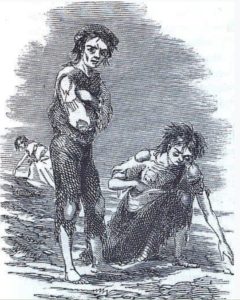
Scene at Skibbereen during the Great Famine by Cork artist, James Mahony The Illustrated London News, 1847 (reprinted from Wikipedia)
As this is a Bristol blog, I wondered how the Famine disaster, the loss of the potato harvest in successive years was reported in the Bristol papers.
Bristol Times & Mirror, 10 April 1847, has the following piece from “Dromaleague, March 23rd. At 6:00 a.m. this morning I met a man and a woman on the road, each with a small coffin. I then went to Skibbereen and on the way met a man with a coffin wrapped in a cloth, laid before him on his horse. In Skibbereen of course, there were coffins in all directions but so common are they now become they are scarcely observed on the road. You might see pieces of coffins lying in the churchyard here, the bodies having been torn up and devoured by dogs. The head constable told me that on his beat on Sunday, a body was found half eaten and dragged across the walk. People would stop now and again to look at it, talk and curse over it, but no-one removed it until he and his men came up and they buried it. The bodies are hardly buried at all… [one Sunday] we saw a woman with her son on her back; she brought him to be buried without a coffin and when that was done, she went home for another. [The next] Sunday, we saw her again. She had just buried her seventh and last child.”
Felix Farley’s Bristol Journal, (BTM) 1.5.1847:
THE IRISH INVASION. The hordes of Irish who almost daily arrive at Newport and other Welsh ports and are now penetrating as far as the Bank of the Severn, wander about in a state the most wretched. Last week at Charlton an Irishman named Sullivan, his wife and five children were found dying in a hovel near the roadside. They were taken to the workhouse when three of the children died. At the inquest the unhappy father declared in the deepest grief that he came from Ireland with only his passage money in order that when he died, he might not be eaten by dogs as he had seen bodies eaten near Skibbereen. The remainder of the family remain in a dying state.
Whilst the latter part suggests a degree of sympathy the language of the first line, “Invasion…. Hordes …. Penetrating”, words with undertones of censure would not be out of place in some quarters even today, and the next is disguised rabble-rousing:
The Bristol Times and Mirror, 10 April 1847, bemoans an
INFLUX OF IRISH INTO BRISTOL. We regret to state that the poor rates in Bristol are likely to be much increased in consequence of the numbers of Irish men, women and children, which are brought over by the steam packets of Ireland. Sympathy for the distress which prevails is likely to be much less and through the imposition of many who though in tolerably comfortable circumstances represent themselves as starving and penniless. One of several cases of imposition which has come to our knowledge: on Thursday evening a woman applied for relief St Peter’s Hospital stating that she was without the means of purchasing food when a few minutes previously she had been seen to hand over 15 sovereigns to a companion.
On a more positive note, you could generally rely on the Quakers for compassion and action:
Bristol Mercury 1.9.1848:
FRIENDS IN NEED. November 1846 to the 1st of May 1848 the Friends in England, Ireland and America contributed £193,882 4s 10d for the relief of distress in Ireland. The central relief committee for the Society of Friends have also entered upon the cultivation of 550 Irish equal to 900 English acres of land in the county of Mayo with a view of introducing improvements in husbandry.
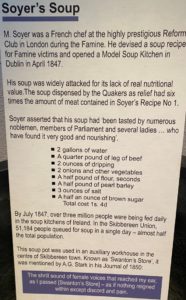 Though it was a spit in the ocean when compared to the need.
Though it was a spit in the ocean when compared to the need.
…… again, (left) the Quakers, otherwise the Friends, came out on top when their soup was compared to that invented by the chef at the Reform Club, & allegedly approved by the nobs, male and female. NB: Even the flour was second rate.
And here a cheer from me for Mr E.V. Paul, of Picton Street, Bristol who raised the sum of £55 to aid the starving Irish which Bristol Times & Mirror forwarded to Ireland, “where it was nost gratefully received.”
Back to soup, in May 1847, “The celebrated physician Sir Henry Marsh, has published a small pamphlet in which he says if a soup diet be relied on in Ireland to any considerable extent, the population will be carried off by dysentery.”
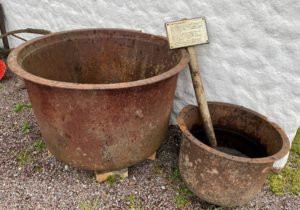
Soup pots, large and small, exhibited in the Bog Village (we were there a few days later), and straightaway we thought of home – we have the larger twin in our back garden, discarded as waste, which George picked up on his travels. Ours is now a pond for a water lily. Maybe it was once used in an English workhouse? A grim reminder of terrible times then and now. Think of the wicked shambolic food distribution in Gaza with even less organisation, and cruel loss of life. Starvation 1845 or 2025 where’s the difference?
Though he knew of the situation from reading beforehand, George was emotionally and personally affected by Skibbereen.
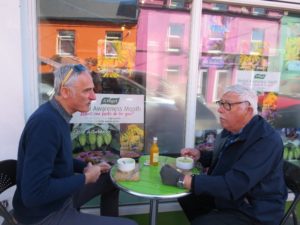
This photo is a cheat – it was taken later when George was in fact quite cheerful, having just been beguiled by a colleen, who was serving in this café. Who’d a thought it? He was suffering because of his left hand, the agony of Calpel Tunnel syndrome.
Back when he was sitting outside the Heritage Centre with his thoughts I talked with one of the attendants, telling her of our next intended port of call, Lough Hyne or Ine, Europe’s first Marine Nature Reserve. She pointed me to a book on sale at the stack subtitled “The Marine Researchers – in Pictures”. I riffled through it and was astonished! Despite my limited vision, certain words within a mountain of print stand out if they reflect my lifetime interests; one of these words is of course, BRISTOL, which in this case had the word ‘University’ tacked on. As I made the usual “whoop!” I told the attendant where we came from. She seemed intent in dissuading me from buying the book. “It doesn’t mean to say just because they were at the University,” she reproved, “that they were born there…” She was the resident genealogist and would have preferred it if I had needed help in tracing family members born in the Republic. (Been there, done that!) I apologised for not needing this sort of help and bought the book. It more than added to my expectations. Recorded academic interest in the unique saltwater lake goes back to 1886 and though I cannot guarantee Bristol involvement from that early date, students of the “Bristol University Zoological Society”, boys and girls, first visited in 1937 and from that time, apart from a hiatus 1940-5, camped on the shores of the Lough well into the 1980s and even later as pictures witness. At least one of the Bristol students, John Ebling, who was part of the 1937 group when he was aged nineteen was still carrying out annual studies there in 1976. The informal pictures of the groups, baggy shorts, canvas tents, primitive diving equipment and all, plus changing fashions, (by 1971 the boys all had long hair), depict an idyll of a long-gone age. I hope the young people knew how lucky they were in the 1930s, and even the 1946-50s, especially the girls.
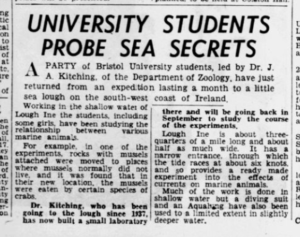 Note the wide-eyed wonder in the Bristol Evening Post, 16 August 1958, that the party included “some girls”. (In the 1950s, in our street, a sighting of me in jeans could cause an outbreak of raised eyebrows.)
Note the wide-eyed wonder in the Bristol Evening Post, 16 August 1958, that the party included “some girls”. (In the 1950s, in our street, a sighting of me in jeans could cause an outbreak of raised eyebrows.)
If you know me at all, you will be aware of my liking for lists. These are the names from the Bristol University groups over the years included in “Lough Hyne – The Marine Researchers – in Pictures” by Terri Kearney. They are very happy, informal snaps from private collections. Those who appear twice in the captions went to the Lough several times. If any name rings a bell with somebody, please let me know, or in fact anybody else with memories of the research camps, so that I can inform the Skibbereen Heritage Centre.
| 1937: John Ebling | Muriel Ruddock | John Spalding |
| Ruth Parry | —– Popham | Peggy Bowen |
| H. Gorvett | H.F. Steadman | Jean M. Fry |
| Desmond Womack | Nora Summers | Donald Parry |
| 1938: S. Bennett | Jean M. Fry | H. Gorvett |
| J.S. Hellier | Donald Parry | Ruth Parry |
| R. (Dick) Purchon | H.F. Steadman | Nita Wigmore |
| John Ebling | Jack Kitching | |
| 1939: Ronald Bassindale | Margaret Johnson | Dick Purchon |
| Kathleen Simpson | Ruth Parry | Jerry Walton |
| 1946: John Ebling | Ronald Bassindale | Pat Smith |
| Avice Brindley | Constance Plaice | Phyllis Whitton (sister of Ron Bassindale) “came as cook”* |
| 1948: Erica Ebling | John Ebling | Jack Kitching |
| Sylvia J. Lily | Dick Purchon | |
| 1950: Ronald Bassindale | Jack Kitching | Jack Sloane (lecturer) |
| Sheila Hooks | Sheila Lodge (IOM) | Alan Peters |
| John Chriswell | Pat Scholes | Arthur Lucas |
| 1951: John Peters | Jack Sloane | Eileen Walden |
| Anne Legg | John Peters | Cathie Young |
| John Kay | Pat Scholes | Audrey Fisher |
| 1952: Michael Sleigh | Jill Ilette | Jeannette Dale |
| Chris Trewhella | Anne Wilson | Arthur Lucas |
| 1953: Cynthia Dutton | Liz Davenport | Roger Buckart |
| Ronald Bassindale | David Garrod | Eiry Davies |
| Jock Sloane | Anna Kirsch | Margaret Stallard |
| Jack Kitching | Rosemary Cowls | Mac Hunter |
| Roger Brehaut | Michael Sleigh | Erica Ebling |
| John Ebling | Roger Stobbard | Cynthia Dutton |
| Ernie Donelan (local) | John Gray | Liz Davenport |
| Rachel Stephens | Brian Salman | |
| 1955: Liz Mallinson | Millie Larter | Pat Scholes |
| Sheila Lodge | Pat Heaysman | |
| 1956: Peggy Grunwell | Brian Salman | Rachel Stephens |
| 1959: Eirlys Griffiths | Marion Ferguson | Louise Muntz |
| 1960: Liz Cross | ||
| 1962: Mary Taylor | Malcolm Penny | Roy Blackman |
| Julia Sharpe | Tony Hawkins (with his wife Susan continues to visit until this day) |
Anne James |
| Linda Jennings | Alan Preece | Jack Kitching |
| 1963: Robin Baker | Viv Pratt | Mary Malcolm |
| 1964: Mrs Mary Penny, nee Taylor (mar. Malcolm Penny 1964) | A. Smith | |
| John Ebling | L. Nockles | J. Young |
| J. Harman | B. Merrifield | B. Leckie |
| R. Burns | M. Clegg | Trevor Norton |
| D. Marsh | ||
| 1966: Peter Cox | Rod Casey | Dave Vickers |
| Lyn Sims | Peter Haan | Gerald Walton |
| 1967/8: John Thain | Viv Thain, nee Pratt (still a regular visitor to Lough Hyne | Viv was Jack Kitching’s PhD student at Bristol |
| Louise Muntz | ||
| 1970: Rosemary Firth | Trevor Norton | |
| 1971: Frank Round | ||
| 1979: Colin Little | Paddy Paterson | |
| 1981: Michael Edgeley | Colin Little | John Thain |
| Marian Thain, (child) | ||
| 1982: Simon Thrush | Julian Partridge | Sarah Gledhill |
*I am happy to say domestic and other chores, except cooking apparently, were undertaken by both sexes.
Research at Lough Hyne continues until this day, which goes only to show that every answer throws up at least another half dozen questions, so you can never know everything but can spend a lifetime looking. In 2008, one groups of researchers gave Colin Little an anniversary cake inscribed “Lough Hyne. 30 years of dabbling in the waters.”
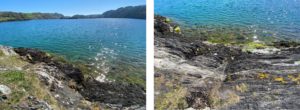
I am not clever enough to adequately describe landscape, so above you will see a couple of our pictures. Our stay was all too brief, but I can understand why our university predecessors were so taken with the place they came back year after year.
I spent a few convivial moments with an Irishwoman, who was visiting with her children, and who sat on the wall beside me; not for the first time the conversation started – “Sure, an’ you’ve brought the weather with you,” – I told her I would include her in my blog, but she was too shy to say her name. (She probably went home and said, “Some old English Nut gave me the link to her website.”)
After this it was off to one of the nature walks beside the singing of a tumbling brook, complete with compulsory shrines, dedicated to Mary, the mother of Jesus.
I dipped my hands in, splashed my eyes, and filled a small bottle with the sparkling ice-cold water, which allegedly cures dodgy sight, and “Lo!” in the next picture you can see the proof of previous miracles…….

……pairs of discarded glasses left by the cured.
Somewhere on our way I lost my phial of Holy Water. It is therefore no wonder that my right eye is still blind. Perhaps the splash of water at the shrine will help save the left until I no longer need it. That will be miracle enough.
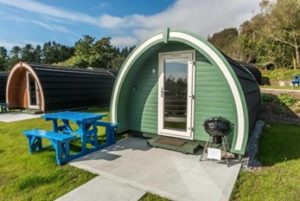 And so on to fish and chips and Bearehaven Pods for the night.
And so on to fish and chips and Bearehaven Pods for the night.
It soon “blew up” in the evening, as my Mum would have said, and was chilly out on the bench as soon as the sun set; it was still April after all. When he came back from his evening’s bird watching – feathered variety – Kevin joined us in our pod for the 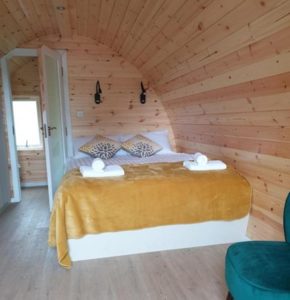 compulsory “few beers”, in my case, wine. Pity we didn’t have an inside table. Never mind. Still in pious mode, I had an idea. We are all familiar with the Seven Deadly Sins. What are the equivalent seven virtues?
compulsory “few beers”, in my case, wine. Pity we didn’t have an inside table. Never mind. Still in pious mode, I had an idea. We are all familiar with the Seven Deadly Sins. What are the equivalent seven virtues?
These are a few we debated: Courage, Honesty, Curiosity, Practicality, Ability, Humour, Intelligence, Reliability, Empathy, Equality/Fairness, Wisdom, Common Sense, Punctuality, Co-operation, Thoughtfulness, Friendship. Kevin said Kindness could be taken as read as it was covered already within some of these, thanks to the nuance of the English language. George suggested “Able to see the bigger picture” which we all agreed was great but couldn’t think of one word to describe it. (Later Dr Google supplied Holistic/Strategic/Perceptive.)
And so to bed.
Space. It’s an illusion. Guess who was up against the wall…….


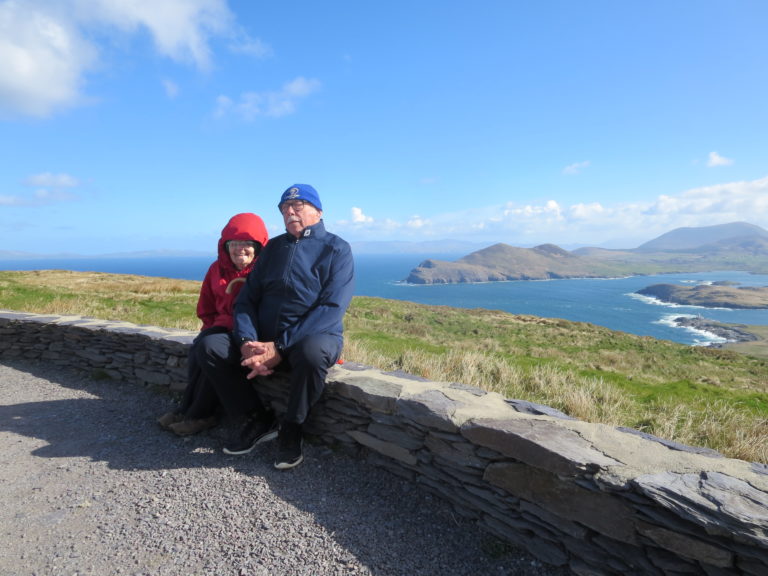
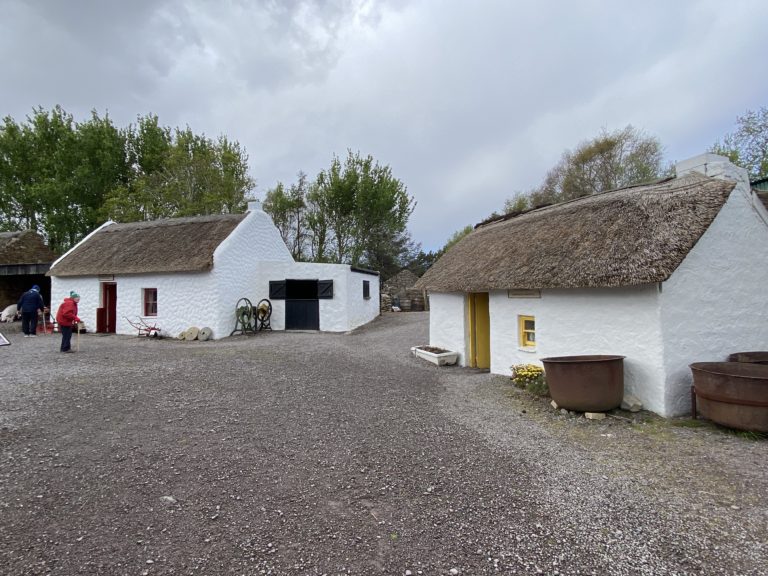
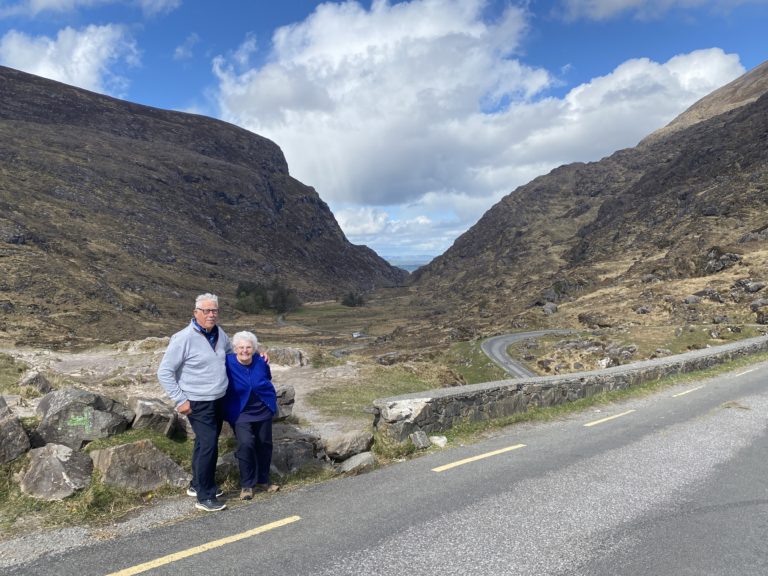
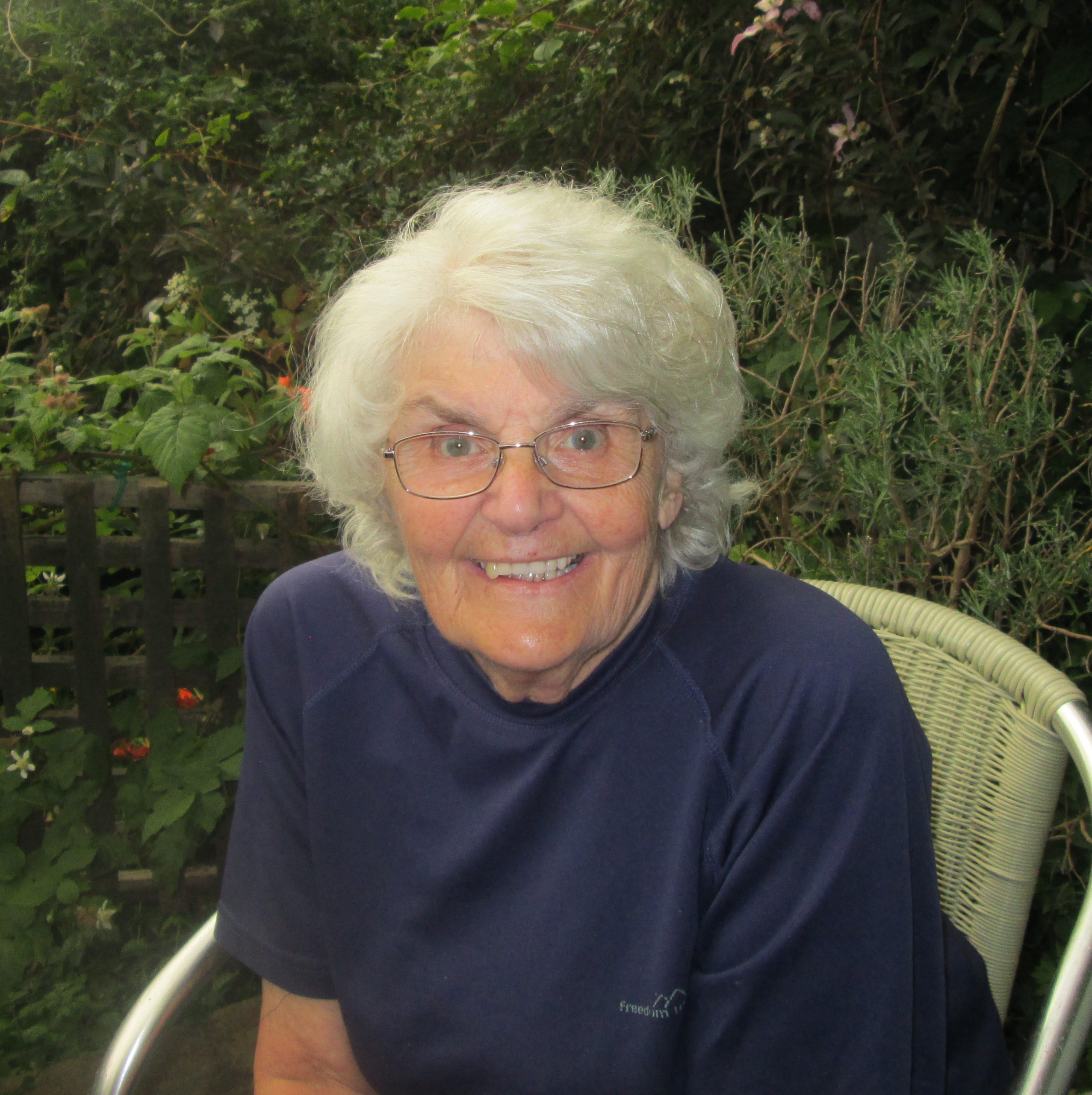



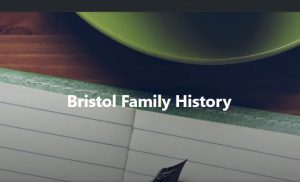
Leave a Comment